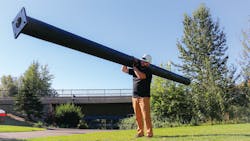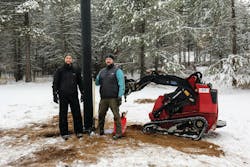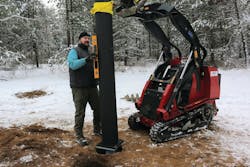Making Small Cell Towers More Sustainable
Are Composites the Answer?
With an exponential need for data worldwide, and the predicted demand in associated 5G and IoT infrastructure, the telecom industry finds itself facing an interesting problem. With all the talk of high tech, there still must be an actual physical system to support the equipment. Even as they seek to build-out this tower-intensive infrastructure, communities, carriers, and installers are simultaneously seeking ways to lower carbon footprint, prolong usability and increase sustainability, as well as to decrease pollution, noise, and traffic impacts.
By 2050, when the global population is projected to increase to around 9.8 billion, it’s estimated that more than twice as many people in the world will be living in urban (6.7 billion) than in rural settings (3.1 billion), says Our World in Data.
In this light, traditional metal and wood as tower materials are proving problematic on several environmental fronts. The quest is for another type of small cell infrastructure solution, one which fits the world’s rapidly growing need for ultra-high-speed communications, yet with diminished impact on increasingly populated urban spaces.
Cities account for more than 70% of global energy-related CO2 emissions and an estimated 50% of global waste. In Europe, 85% of people already live in urban areas, according to the European Commission. By 2050, when the global population is projected to increase to around 9.8 billion, it’s estimated that more than twice as many people in the world will be living in urban (6.7 billion) than in rural settings (3.1 billion), says Our World in Data. At the same time, cities are laboring to become more ecologically responsible and enact policies around sustainability.
One of the latest challenges for would-be smart cities is the rollout of 5G connectivity. With a shorter wavelength, 5G demands small cell installations at approximately every 800 to 1,000 feet to provide uninterrupted connectivity for both User Equipment (UE) and Internet of Things (IoT) devices. While many of the new installations will use existing towers and other infrastructure, urban densification still calls for an enormous build-out of new towers, which will create corresponding environmental degradation if traditional methods continue to be used.
Most existing small cell towers are made of steel, aluminum, or wood, and are installed using a team of four to six workers. These teams use gas-powered, heavy-duty equipment to transport, hoist and then lower the towers into place. Both steel and aluminum are obtained by open pit mining, and their refining releases dangerous emissions including CO, SOx, NOx, PM2, as well as wastewater contaminants. Additional air pollution comes from diesel generators, trucks, and other mining equipment. Steel production is a major contributor to global warming, adding more than 3.3 million tons annually to global emissions, according to figures from The World Counts. On average, 1.83 tons of CO2 are emitted for every ton of steel produced, according to Carbon Clean. Aluminum has an even more onerous carbon footprint. Each ton of aluminum emits 11.7 tons of carbon, nearly six times that of steel.
The average lifespan for steel and aluminum towers is 15-30 years, depending on variables such as local weather and how well the tower is constructed and finished. Replacement of corroded or weather-damaged towers is an ongoing problem. To recycle steel, material is shredded and then melted to create new sheets of metal. But if the rust on steel towers is melted, it reforms once the metal cools, demanding more complex and time-consuming recycling processes.
With all the talk of high tech, there still must be an actual physical system to support the equipment. Even as they seek to build-out this tower-intensive infrastructure, communities and carriers must lower their carbon footprint, prolong usability, and increase sustainability, as well as decrease pollution, noise, and traffic impacts.
Wooden towers, most commonly made from western red cedar, Douglas fir, and southern pine, also impact the environment. They are often treated with pentachlorophenol (PCP) to protect them against fungi and termites. Copper, chromium, arsenic, and creosote are also used. The EPA has calculated that children face 220 times the usual risk of cancer from exposure to soil contaminated with PCP, according to the Earth Island Journal. The chemical is also highly toxic to birds, mammals, and aquatic organisms as well as plant life.
Another consideration is shipping, handling, and storing the towers. This journey from manufacturing site to warehouse or job site to final installation site is a significant part of the environmental footprint. The heavy weight of metal and even wood towers contribute to measurable emissions at every step along the transportation pathway.
The next step in the journey of a typical small cell tower is installation. In the case of traditional metal towers, this process usually takes at least two days, and sometimes longer. During this time, traffic is either waiting and idling or being rerouted around the site, increasing CO2 production. Emissions and noise pollution from the heavy equipment is also an issue. And the heavy weight of steel towers demands substantial foundation work such as new or deeper concrete caissons. These require concrete and pump trucks which add additional emission burdens to the carbon footprint.
Steel, aluminum, and wood towers are secured using concrete foundations. The cement industry is a leading producer of carbon dioxide, creating up to 8% of worldwide man-made emissions, both from the chemical process and from burning fuel used in its manufacture. Ranked alongside CO2 emissions from individual countries, the cement industry is the third-highest emitter after China and the United States, according to The Guardian.
Glass Towers?
Thankfully, there is a better way and a more sustainable small cell tower. The solution uses glass fiber. Glass fiber’s primary component, sand, is readily available and constantly renewing. Because glass fiber is extremely lightweight, a cement base is unneeded. Instead, the composite tower is anchored using sustainable, quick-curing, polyurethane foam.
Glass fiber offers the same strength and stiffness as metal and is actually more impact resistant. It requires no maintenance and is not prone to degradation by moisture nor impacted by UV. A polyurea coating to the tower provides further UV and corrosion resistance. Polyurea is free from solvents and contains neither plasticizers nor volatile organic compounds.
Glass fiber is also easy to transport. Because it weighs 60-90% less than steel, it requires significantly less fuel for transportation and hence creates fewer emissions. Lightweight construction also means that a small crew of two or three workers can install a steel-equivalent 30-foot-tall, 210-pound composite tower in about two hours. Installation uses primarily hand tools, minimizing air and noise pollution, and takes hours rather than days, which facilitates traffic flow and cuts down on emissions from idling vehicles.
Composite towers utilize an efficient, low emission process called pultrusion. Towers can be manufactured in any length, reducing the need for retooling. The process requires far less heat than manufacturing aluminum and steel, reducing the amount of water needed for cooling. Washington State-based EasyStreet Systems is one manufacturer of such a tower.
While many of the new installations will use existing towers and other infrastructure, urban densification still calls for an enormous build-out of new towers, which will create corresponding environmental degradation if traditional methods continue to be used.
At a glance, the two major objectives for telecom’s next big push into 5G, IoT and Smart Cities would seem to be at direct odds: Build-out a dense infrastructure as quickly and nimbly as possible, while minimizing critical impacts to air, soil, water, abating noise and ultimately lessening the overall environmental impacts of this installation to booming city populations and the planet. Thankfully, composite towers, sustainably created with a primary ingredient of glass fiber, and shipped and installed within significantly lower particulate and noise thresholds, can accomplish both objectives equally well.
As metal and wood materials of the past become increasingly difficult to source, and onerous to install and maintain, composite glass fiber towers would very much appear to be the way of the future.
ABOUT THE AUTHOR
Mary Chase, Ph.D., is a researcher and writer based in Portland, Oregon, who specializes in translating complex information into accessible text across a variety of audiences. Her background is in technology, cognitive psychology, and semantics. For more information, please email [email protected] or visit https://easystreetsystems.com/. You can also follow EasyStreet Systems on Twitter @easystreetsys and LinkedIn: https://www.linkedin.com/company/easystreet-systems.
About the Author
Mary Chase, Ph.D.
Researcher and Writer Based in Portland, Oregon
Mary Chase, Ph.D., is a researcher and writer based in Portland, Oregon, who specializes in translating complex information into accessible text across a variety of audiences. Her background is in technology, cognitive psychology, and semantics. For more information, please email [email protected] or visit https://easystreetsystems.com/. You can also follow EasyStreet Systems on Twitter @easystreetsys and LinkedIn: https://www.linkedin.com/company/easystreet-systems.


